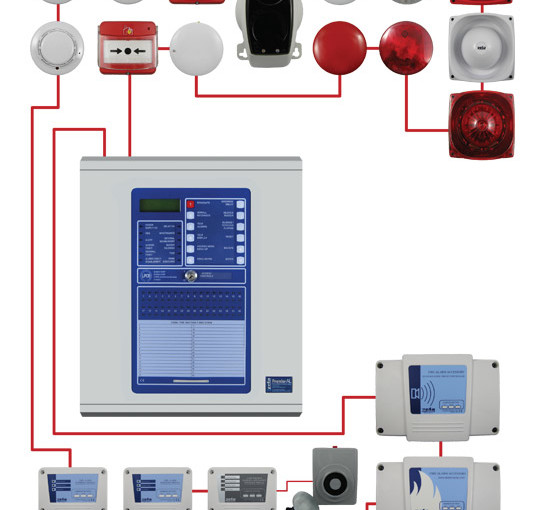Products

Addressable Fire Alarm System
An automatic fire alarm system is designed to detect the unwanted presence of fire by monitoring environmental changes associated with combustion. In general, a fire alarm system is classified as either automatically actuated, manually actuated, or both. Addressable Fire Alarm System can be used to notify people to evacuate in the event of a fire or other emergency, to summon emergency services, and to prepare the structure and associated systems to control the spread of fire and smoke.
After the fire protection goals are established – usually by referencing the minimum levels of protection mandated by the appropriate model building code, insurance agencies, and other authorities – the fire alarm designer undertakes to detail specific components, arrangements, and interfaces necessary to accomplish these goals.
Equipment specifically manufactured for these purposes are selected and standardized installation methods are anticipated during the design.
Fundamental Configuration
- Fire alarm control panel: This component, the hub of the system, monitors inputs and system integrity, controls outputs and relays information.
- Primary Power supply: Commonly the non-switched 120 or 240 Volt Alternating Current source supplied from a commercial power utility. In non-residential applications, a branch circuit is dedicated to the fire alarm system and its constituents. “Dedicated branch circuits” should not be confused with “Individual branch circuits” which supply energy to a single appliance.
- Secondary (backup) Power supplies: This component, commonly consisting of sealed lead-acid storage batteries or other emergency sources including generators, is used to supply energy in the event of a primary power failure.
- Initiating Devices: This component acts as an input to the fire alarm control unit and are either manually or automatically actuated. Examples would be devices like pull stations or smoke detectors.
- Notification appliances: This component uses energy supplied from the fire alarm system or other stored energy source, to inform the proximate persons of the need to take action, usually to evacuate. This is done by means of a flashing light, strobe light, electromechanical horn, speaker, or a combination of these devices.
- Building Safety Interfaces: This interface allows the fire alarm system to control aspects of the built environment and to prepare the building for fire and to control the spread of smoke fumes and fire by influencing air movement, lighting, process control, human transport and exit.
Notification appliances
- Audible, visible, tactile, textual or even olfactory stimuli (odorizer) to alert the occupants. Audible or visible signals are the most common and may utilize speakers to deliver live or pre-recorded instructions to the occupants. In the United States, fire alarm evacuation signals are required to use a standardized interrupted four count temporal pattern to avoid confusion with other signals using similar sounding appliances. Other methods include:
- Audible textual appliances, which are employed as part of a fire alarm system that includes Emergency Voice Alarm Communications (EVAC) capabilities. High reliability speakers are used to notify the occupants of the need for action in connection with a fire or other emergency. These speakers are employed in large facilities where general undirected evacuation is considered impracticable or undesirable.
- The signals from the speakers are used to direct the occupant’s response. The system may be controlled from one or more locations within the building known as Fire Wardens Stations, or from a single location designated as the building Fire Command Center. Speakers are automatically actuated by the fire alarm system in a fire event, and following a pre-alert tone, selected groups of speakers may transmit one or more prerecorded messages directing the occupants to safety.
- These messages may be repeated in one or more languages. Trained personnel activating and speaking into a dedicated microphone can suppress the replay of automated messages in order to initiate or relay real time voice instructions.
Building safety interfaces
- Magnetic Smoke Door Holders: Wall or floor mounted solenoids or electromagnets controlled by a fire alarm system or detection component that magnetically secures spring-loaded self-closing smoke tight doors in the open position.
- Designed to de-magnetize to allow automatic closure of the door on command from the fire control or upon failure of the power source, interconnection or controlling element. Stored energy in the form of a spring or gravity can then close the door to restrict the passage of smoke from one space to another in an effort to maintain a tenable atmosphere on either side of the door during evacuation and fire fighting efforts.
- Duct Mounted Smoke Detection: Smoke detection mounted in such a manner as to sample the airflow through duct work and other plenums specifically fabricated for the transport of environmental air into conditioned spaces. Interconnection to the fan motor control circuits are intended to stop air movement, close dampers and generally prevent the recirculation of toxic smoke and fumes produced by fire into occupiable spaces.


